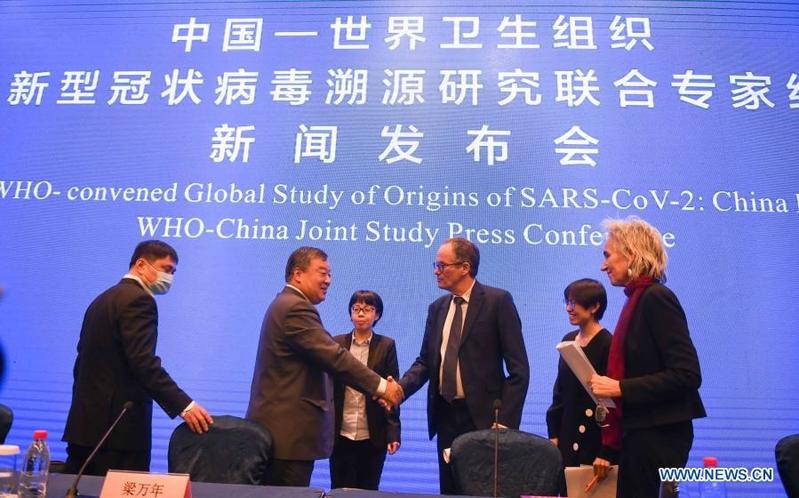 Liang Wannian (2nd left) and Peter Ben Embarek (3rd right), both members of the WHO-China joint study team, shake hands after the WHO-China joint study press conference in Wuhan, central China's Hubei province, Feb 9, 2021. (CHENG MIN / XINHUA)
Liang Wannian (2nd left) and Peter Ben Embarek (3rd right), both members of the WHO-China joint study team, shake hands after the WHO-China joint study press conference in Wuhan, central China's Hubei province, Feb 9, 2021. (CHENG MIN / XINHUA)
It is "extremely unlikely" that the novel coronavirus spread to humans through a laboratory leak, a team of international experts from the World Health Organization said on Tuesday, adding that future studies into the origin of the virus will head "wherever indicated" and not be "geographically bound".
The team's fieldwork in Wuhan and its discussion with local scientists support dismissing the theory that a laboratory incident triggered the outbreak, Peter Ben Embarek, a WHO expert on animal disease and food safety
No known viruses being studied or identified in laboratories around the world have been found to be closely linked to the novel coronavirus, and the team's fieldwork in Wuhan, Hubei province, in the past four weeks and its discussion with local scientists support dismissing the theory that a laboratory incident triggered the outbreak, Peter Ben Embarek, a WHO expert on animal disease and food safety, said during a news conference.
Referring to the Chinese Academy of Sciences' Wuhan Institute of Virology, he said the state of the laboratory shows that "it was very unlikely that anything could escape from that place".
READ MORE: US urged to invite WHO for tracing
With the possibility of a laboratory leak being highly unlikely, Embarek suggested focusing on rational facts at hand and conducting systematic analysis.
"It is a much more useful approach than to put personal feelings and views or only looking at half the arguments," he said.
Embarek heads a 17-member international team of experts convened by the WHO for origin-tracing of the novel coronavirus in Wuhan together with Chinese experts from Jan 10 to Tuesday.
ALSO READ: WHO expert team 'granted full access in Wuhan'
Their work in China has shown that the most likely path for the introduction of the virus to the human population is through an intermediary species, Embarek said, adding that the possibility of two other routes examined by the team-from an animal host to humans and transmission through cold or frozen food-has not been ruled out.
He underscored that, future research into the virus' origin should not be confined to certain regions.
Embarek said that the possible transfer of the virus from animal hosts to humans "could have taken a long and convoluted path, involving movement and travel across borders before arriving in Huanan market". Some of the earliest cases detected in Wuhan, in December 2019, were linked to but not confined to the market.
The possibility of two other routes examined by the team-from an animal host to humans and transmission through cold or frozen food-has not been ruled out
"We need to conduct more surveys into certain animal species that could act as a reservoir, including more sampling and study of the bat population, not only in China where a lot of bats have already been tested," he said.
"Some of the similar species found in China are also found in neighboring countries and in other parts of the world," he said, adding that the bat population outside China has not yet been sufficiently tracked and tested.
Based on the team's research thus far, bats and pangolins have been identified as the likeliest reservoirs of the virus, but genome sequences of coronaviruses found in them are not sufficiently similar to the virus circulating in the public to ascertain their roles.
Liang Wannian, head of the China team in the joint study, said mass testing of animal products from the Huanan Seafood Market, bats in Hubei, and livestock, poultry and wild animals across the country have so far not detected traces of the virus.
"The virus may have made its way into the market by infected personnel, contaminated goods in cold-chain logistics, animal products or other means," Liang said.
Marion Koopmans, a virologist and a team member, said to better understand the virus' origin, more efforts should be devoted to finding and analyzing an earlier spread of the virus.



